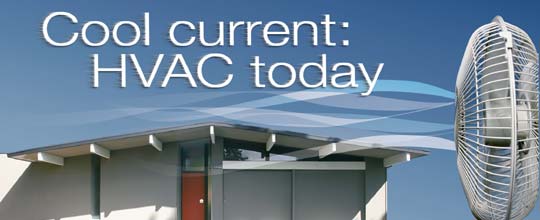Cool Current Today: Air Conditioning and Back-Up Heating
When summertime temperatures swell above 90 degrees, it takes more than an icy Popsicle or a daiquiri for the average homeowner to stay cool. Between heat gain from large, single-pane windows and the lack of insulation and reflectivity on original tar-and-gravel roofs, mid-century modern homes can quickly turn into stifling saunas on a hot summer day.
At times like this, air conditioning can be a dream come true.

Traditional window-type air-conditioning units, commonly found in conventional homes, help keep heat at bay one room at a time, but these noisy, unattractive boxes can be inefficient and even invite intruders. Traditional rooftop HVAC (heating, ventilation, and air conditioning) units, with their tangle of unsightly ductwork, also clash with the streamlined, mid-century modern aesthetic. You may stay cool, but your neighbors will not thank you.

On the flip side, many original Eichler radiant-heat systems, especially the steel ones, are fading out, leaving homeowners chilly in the winter. Few have the chutzpa to clear out the furnishings in their home, re-groove the concrete slab, and replace their defunct radiant system with a new one. It's a time-consuming, inconvenient, and costly proposition. This forces many homeowners on a quest for efficient supplemental and replacement heat sources. And even if a home's radiant is still kicking, it's nice to have the option to flip a switch and get a quick burst of heat when needed.
As much as half of the energy used in our homes goes to cooling and heating, so making smart decisions about upgrading HVAC systems can have a big effect on utility bills—and comfort. Enter today's improved heating and cooling options. We've rounded up the best low-profile, streamlined systems that fit in with modern aesthetic.
Low-Profile Rooftop Systems

At the top of the list for aesthetically pleasing options are the elegant, yet somewhat expensive, low-profile rooftop systems. Low-profile technology has been around for 20 years, and HVAC specialists recommend it for historic homes because of its streamlined nature and capability of providing both heating and cooling.
Both the Unico and SpacePak heating and cooling systems can be retrofitted without compromising the design or architectural integrity of even flat-roof homes. Their two-inch high-velocity supply ducts fit where conventional heating and cooling ductwork can't: encased under foam roofs and slipped through existing ceilings without remodeling.
The Unico and SpacePak whole-house systems, including installation, range in price from $24,000 to $28,000 for the average flat-roof mid-century modern home, but that does not include the cost for a new foam roof, which is a necessary complement for the install. "You have to do the roof and perhaps even get the electrical upgraded when you do these systems," says Kevin Stover of Downing Heating & Air Conditioning in San Rafael.
The core of the Unico system is the air handler, which is made up of the blower housing and fan coil modules. The homeowner chooses from an air handler that cools, heats, or does both, and it is usually installed on the roof. The air handler connects to two-inch ducts that run across the roof and pop through the roof to the interior ceiling to a choice of inconspicuous outlets: the two-inch round or an eight-inch by 3/4-inch slotted diffuser. The outlets come in a variety of styles, including wood finishes, plastic, and metals that blend into any decor.
"When we have visitors come to our house, they commonly mistaken the small two-inch round registers [positioned on the ceilings] as recessed lighting," says East Bay Eichler owner Alexander Victa, who likes the subtle impact the Unico has on his interior. "We also appreciate how the house's temperature throughout remains relatively even without cold or hot spots favoring certain rooms."
Unico offers a variety of options for these systems, including a return air box, drop box, humidifier, and air filter for fresher, cleaner air. A UV light option also destroys bacteria before the air is blown throughout the home. Another option is the UniChiller, an exterior unit that creates zone cooling.
Allow three weeks for the installation of a Unico system when a new roof, and perhaps solar panels, are part of the project.
Kevin Bock, owner of AirQwest Heating & Air Conditioning, which services Palm Springs and Southern California, says he prefers the SpacePak system because it is easy to install, with connects that join parts without tools.




